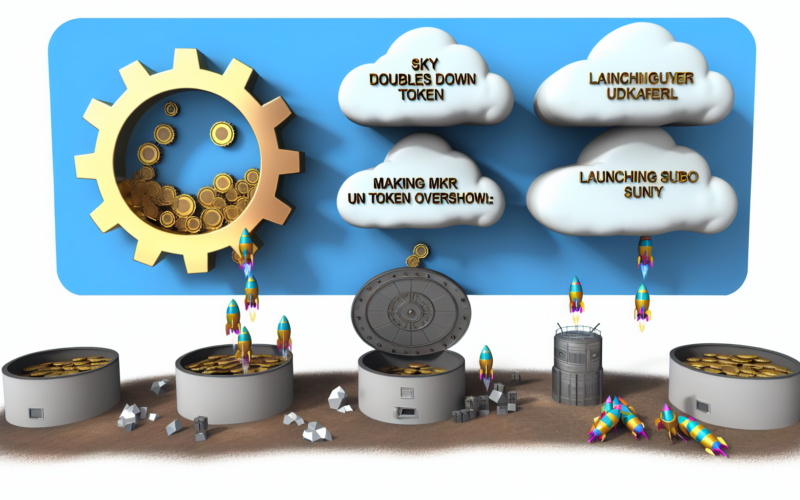Headline: Sky speeds up MKR to #SKY migration for 2025, aiming to simplify tokenomics and introduce new Stars in DeFi. #Crypto #Blockchain
Tags: #SKY, #Crypto, #Blockchain
- Introduction
- Background and Context
- Main Explanation
- Challenges and Opportunities
- Future Outlook
- Conclusion
Introduction
In the rapidly evolving world of decentralized finance (DeFi), change is the only constant. Sky, a pioneering DeFi lending platform previously known as Maker, is once again at the forefront of innovation. The platform is embarking on a significant transformation journey, aiming to transition from MKR to a new token, SKY. This strategic shift, spearheaded by Rune Christensen, co-founder of Sky, promises to redefine the landscape of DeFi. As we delve deeper into this topic, we’ll explore the motivations behind this migration, its implications for token holders, and the future of the Sky ecosystem. This article will guide you through the intricacies of this transition, providing insights into the potential challenges and opportunities it presents.
Background and Context
The journey of Sky began as Maker, a well-established name in the DeFi ecosystem. Known for its innovative solutions and stablecoin DAI, Maker has been a cornerstone in the decentralized financial landscape. However, as the DeFi space matured, the need for evolution became apparent. In August, Maker underwent a massive rebranding, emerging as Sky. This change was more than just a name swap; it signaled a strategic pivot towards a more streamlined and efficient ecosystem. The decision to transition from MKR to SKY is rooted in the desire to simplify the tokenomics and remove any confusion surrounding the two tokens. This strategic move is not only about technical optimization but also about aligning the platform with the future needs of the DeFi community.
Main Explanation
The Evolution from MKR to SKY
The transition from MKR to SKY is a complex process that involves reimagining the tokenomics of the platform. At its core, the goal is to transform MKR into a wrapper token representing 24,000 SKY. This change is set to take full effect by 2025, with efforts underway to ensure a smooth migration. According to Rune Christensen, this migration will not jeopardize MKR tokenholders’ funds. Instead, it will become a requirement for usability, ensuring that all stakeholders are aligned with the new ecosystem.
Tokenomics Redefined: A Deflationary Approach
A key aspect of the transition to SKY is the shift towards a deflationary tokenomics model. This model is characterized by long-term supply reduction and a burn mechanism, designed to increase the value of SKY over time. The decision to adopt a deflationary model was made through a governance vote, reflecting the collective will of the stakeholders. This approach not only enhances the value proposition of SKY but also positions it as a more sustainable and lucrative investment for tokenholders.
Introducing the Star DAO Strategy
As part of its evolutionary strategy, Sky plans to launch more subDAOs, known as Stars, in 2025. These Stars will operate with a foundation model that controls the workforce bonus pool and facilitates quick decision-making. The introduction of Stars is a testament to Sky’s commitment to decentralization and innovation. By empowering subDAOs with greater autonomy, Sky aims to foster a more dynamic and responsive ecosystem. The first subDAO, Spark, is set to launch soon, marking the beginning of this new chapter in Sky’s journey.
Challenges and Opportunities
Addressing Potential Challenges
The transition from MKR to SKY is not without its challenges. One of the primary concerns is the potential confusion among existing tokenholders. To mitigate this, Sky is committed to providing clear and timely updates throughout the migration process. Another challenge lies in ensuring that exchanges and platforms like CoinGecko fully support the new SKY token. Efforts are being made to facilitate this transition smoothly, minimizing any disruptions for users.
Opportunities for Growth and Innovation
Despite the challenges, the transition to SKY presents significant opportunities for growth and innovation. The adoption of a deflationary tokenomics model positions SKY as a valuable asset, attracting new investors and enhancing its market presence. Additionally, the launch of Stars opens new avenues for collaboration and innovation within the DeFi space. By empowering subDAOs, Sky can leverage the diverse talents and expertise of its community, driving the ecosystem forward.
Future Outlook
Looking ahead, the future of Sky and its ecosystem appears promising. The successful migration from MKR to SKY will set a precedent for other DeFi platforms considering similar transformations. As Sky continues to expand its network of Stars, it will likely see increased participation from developers and innovators eager to contribute to the ecosystem. This collaborative approach will not only enhance Sky’s offerings but also solidify its position as a leader in the DeFi space. Furthermore, the deflationary model is expected to drive demand for SKY, making it an attractive option for investors seeking long-term value.
Conclusion
The transition from MKR to SKY marks a significant milestone in the evolution of Sky and the broader DeFi landscape. By embracing a deflationary tokenomics model and launching subDAOs, Sky is positioning itself at the forefront of innovation and growth. As tokenholders and stakeholders navigate this transition, they can look forward to a more streamlined and efficient ecosystem that promises long-term value and sustainability. For those eager to be part of this journey, now is the time to engage with the Sky community and explore the opportunities that lie ahead. The future of DeFi is bright, and Sky is leading the way.











